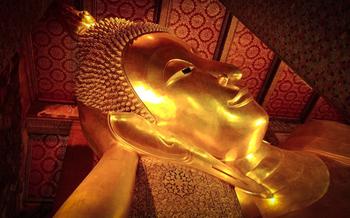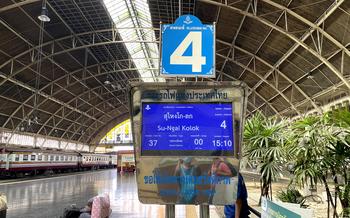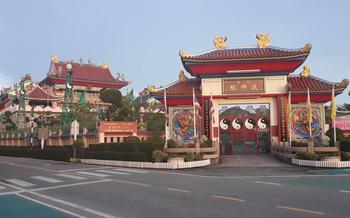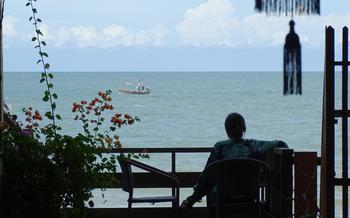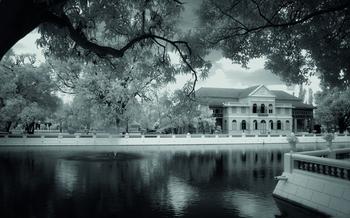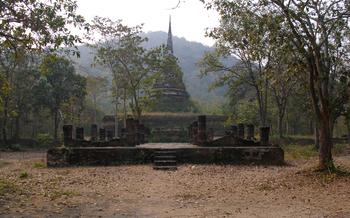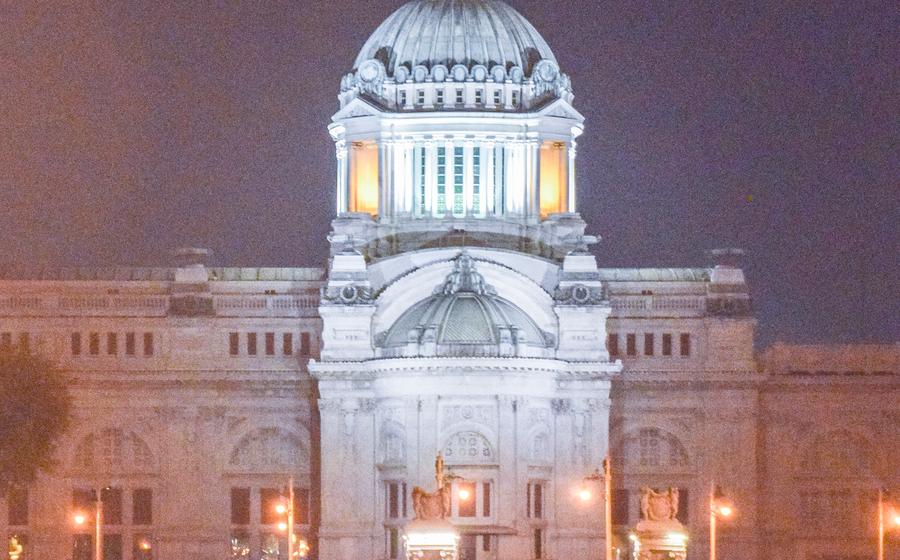
Ananta Samakhom Throne Hall
- The Grand Palace: An Overview
- Ananta Samakhom Throne Hall: A Masterpiece of Architecture
- Exploring the Throne Hall's Exterior
- Symbolic Sculptures and Their Meanings
- Panoramic Views and Photo Opportunities
- Capturing the Grandeur
- Delving into the Throne Hall's Interior
- The Throne Hall's Role in Royal Ceremonies
- Planning Your Visit to the Throne Hall
- Dress Code and Etiquette
- Unveiling the Throne Hall's Hidden Gems
- A Walk Through History: The Throne Hall's Past
- Ananta Samakhom Throne Hall's Cultural Significance
- The Throne Hall and Thai Identity
- The Throne Hall in Literature and Arts
- Preserving the Throne Hall for Future Generations
- Events and Exhibitions at the Throne Hall
- Insider Tip: Unveiling the Throne Hall's Hidden Treasures
The Grand Palace: An Overview
The Grand Palace, an iconic landmark in Bangkok, Thailand, is a sprawling complex of buildings, temples, and courtyards that served as the official residence of the Thai monarchy for over 150 years. This magnificent palace complex, steeped in historical significance and cultural importance, is a testament to Thailand's rich heritage and architectural prowess. Its intricate details, awe-inspiring spires, and opulent decorations showcase the kingdom's artistic and cultural achievements.
Visitors to the Grand Palace are captivated by its grandeur, which reflects the power and prestige of the Thai monarchy. Each section within the palace serves a specific purpose, from the royal reception halls to the temples and living quarters. The palace's intricate architecture, featuring elements of both traditional Thai and Western styles, narrates the story of Thailand's cultural evolution and its interaction with the wider world.
Before embarking on your exploration of the Grand Palace, it's essential to adhere to the strict dress code. Respectful attire, such as long pants or skirts and shirts with sleeves, is required for entry. This dress code reflects the sacred nature of the palace and ensures that visitors show proper respect to the Thai monarchy and its traditions.
Ananta Samakhom Throne Hall: A Masterpiece of Architecture
The Ananta Samakhom Throne Hall stands as a testament to the grandeur and architectural prowess of Thailand. Constructed during the reign of King Chulalongkorn (Rama V), this magnificent edifice was completed in 1915 and served as the venue for royal receptions, state banquets, and other significant events. Its unique architectural style, characterized by a harmonious blend of European neoclassical and traditional Thai elements, sets it apart from other structures within the Grand Palace complex. The hall's facade is adorned with intricate carvings and sculptures depicting mythical creatures and scenes from Thai mythology, showcasing the artistry and craftsmanship of the era. The spacious balconies offer panoramic views of the palace grounds and the surrounding city, making it an ideal vantage point to capture the grandeur of Bangkok.
Exploring the Throne Hall's Exterior
The Ananta Samakhom Throne Hall's exterior is a testament to the intricate artistry and grandeur that characterize Thai architecture. The impressive facade, adorned with intricate carvings and sculptures, captivates visitors with its sheer scale and beauty. Symbolic figures and motifs, deeply rooted in Thai mythology and culture, adorn the facade, adding layers of meaning to the architectural masterpiece.
Spacious balconies, overlooking the sprawling lawns and gardens, offer panoramic views of the palace grounds. These vantage points provide visitors with an opportunity to soak in the beauty of the surroundings and capture stunning photographs that encapsulate the majesty of the throne hall. The exterior of the Ananta Samakhom Throne Hall is not merely a decorative element but an integral part of its storytelling, inviting visitors to delve into the rich history and cultural heritage of Thailand.
Symbolic Sculptures and Their Meanings
The sculptures that adorn the facade of the Ananta Samakhom Throne Hall are not mere embellishments but profound symbols that convey deep cultural and historical significance. Each figure and motif holds a specific meaning, adding layers of narrative to the architectural masterpiece.
Mythical creatures, such as the Garuda, a half-man, half-bird figure, and the Naga, a serpent-like deity, flank the entrance, symbolizing protection and strength. Exquisitely carved floral motifs represent the abundance and fertility of the land, while intricate scrollwork and geometric patterns add a sense of rhythm and harmony to the overall design.
Panoramic Views and Photo Opportunities
The spacious balconies that grace the exterior of the Ananta Samakhom Throne Hall offer visitors breathtaking panoramic views of the palace grounds and beyond. From these vantage points, visitors can capture stunning photographs that encapsulate the grandeur and scale of the throne hall.
The lush green lawns, dotted with colorful flower beds, create a vibrant contrast to the gleaming white facade of the building. In the distance, visitors can admire the spires and domes of other significant landmarks within the palace complex, creating a picturesque panorama that showcases the architectural diversity of the Grand Palace.
Capturing the Grandeur
To fully appreciate the grandeur of the Ananta Samakhom Throne Hall's exterior, visitors are encouraged to take their time exploring its intricate details and capturing the beauty of the architecture through photography. The play of light and shadow, the interplay of colors, and the sheer scale of the building come together to create a mesmerizing spectacle that demands to be documented.
Whether you choose to focus on the intricate carvings, the imposing facade, or the panoramic views, the exterior of the Ananta Samakhom Throne Hall offers a wealth of photo opportunities that will allow you to capture the essence of this architectural masterpiece.
Delving into the Throne Hall's Interior
Stepping into the Ananta Samakhom Throne Hall is like stepping into a world of elegance and grandeur. The grand entrance, with its soaring ceilings and intricate carvings, sets the tone for the awe-inspiring ambiance that awaits within. The centerpiece of the hall is the exquisite throne, a symbol of royal authority and power. Adorned with precious stones and intricate carvings, the throne exudes an aura of majesty and commands attention.
The throne hall is also adorned with stunning murals depicting historical events and royal ceremonies. These murals, created by renowned Thai artists, bring to life the rich history and traditions of the Thai monarchy. The walls are adorned with decorative elements and traditional craftsmanship, showcasing the artistry and attention to detail that went into the creation of this magnificent hall.
Beyond the throne and murals, visitors can admire the intricate carvings, sculptures, and decorative elements that adorn every corner of the hall. These details, often overlooked by the casual observer, reveal the depth of craftsmanship and artistry that went into the creation of this masterpiece.
The Throne Hall's Role in Royal Ceremonies
The Ananta Samakhom Throne Hall has been the stage for numerous royal ceremonies and events throughout Thailand's history. It has witnessed coronations, state banquets, official receptions, and other significant occasions that showcase the splendor of the Thai monarchy.
During these ceremonies, the throne hall is transformed into a majestic setting, adorned with elaborate decorations and royal regalia. The air is filled with anticipation as guests and dignitaries gather to witness the unfolding of ancient traditions and rituals.
One of the most spectacular events held within the throne hall is the coronation ceremony of the Thai monarch. This elaborate ritual marks the formal investiture of the new sovereign and is steeped in centuries-old customs and symbolism.
State banquets are another significant event held in the throne hall. These lavish affairs bring together high-ranking officials, foreign dignitaries, and members of the royal family to celebrate special occasions and strengthen diplomatic ties.
Official receptions and audiences are also held within the throne hall, where the King or Queen receives guests and conducts official business. These events provide an opportunity for the monarch to interact with their subjects and discuss matters of state importance.
The Ananta Samakhom Throne Hall stands as a testament to the continuity of Thai traditions and the enduring legacy of the monarchy. It is a place where ancient customs and modern protocols converge, creating a unique blend of history and contemporary relevance.
Planning Your Visit to the Throne Hall
To make the most of your visit to the Ananta Samakhom Throne Hall, careful planning is essential. The ideal time to visit is during the cooler months, from November to February, to avoid the intense heat and humidity. During this period, you can expect pleasant weather and fewer crowds, allowing for a more enjoyable and comfortable exploration.
Guided tours are available for a more in-depth understanding of the throne hall's history and significance. These tours are led by knowledgeable guides who can provide insights into the architectural features, royal ceremonies, and cultural traditions associated with the hall. Alternatively, if you prefer a self-guided exploration, brochures and audio guides are available to enhance your experience.
For visitors with disabilities, the throne hall is wheelchair accessible, ensuring that everyone can enjoy its grandeur. Ramps, elevators, and accessible restrooms are available, making it convenient for those with mobility limitations to explore the hall's various sections.
Combining the visit to the Ananta Samakhom Throne Hall with other attractions in the area is a great way to maximize your time in Bangkok. The Grand Palace complex itself offers several other notable sights, such as the Emerald Buddha Temple, the Royal Reception Halls, and the Dusit Maha Prasat Throne Hall. By exploring these attractions together, you can gain a comprehensive understanding of Thai history, culture, and architecture.
Dress Code and Etiquette
Visiting the Ananta Samakhom Throne Hall requires adhering to a strict dress code to show respect for the royal institution and the cultural significance of the site. Visitors are expected to dress modestly and appropriately, avoiding shorts, sleeveless shirts, and revealing clothing. It is advisable to wear long pants or skirts that fall below the knees, along with shirts or blouses that cover the shoulders.
When entering the throne hall, it is important to maintain a respectful demeanor and minimize noise. Visitors should avoid talking loudly or engaging in disruptive behavior that might disturb other visitors or detract from the solemn atmosphere of the hall. Following guidelines for photography and videography is also essential, as flash photography and tripods are generally not permitted inside the throne hall to preserve the integrity of the artifacts and artworks.
Unveiling the Throne Hall's Hidden Gems
Beyond the grand facade and ornate interiors, the Ananta Samakhom Throne Hall holds a treasure trove of hidden gems waiting to be discovered. As you explore the vast complex, keep an eye out for these lesser-known features and details that add to the throne hall's allure:
-
Architectural Elements: Look for unique architectural elements such as hidden carvings, intricate moldings, and decorative motifs that adorn the walls, pillars, and ceilings. These details showcase the exceptional craftsmanship and artistry that went into the construction of the throne hall.
-
Symbolic Motifs: Pay attention to the symbolic motifs and iconography incorporated into the throne hall's design. These symbols often hold deep cultural and historical significance, representing aspects of Thai mythology, religion, and monarchy. Discovering these hidden meanings enhances your understanding of the throne hall's cultural significance.
-
Surrounding Gardens: Step out onto the spacious balconies and explore the surrounding gardens and courtyards. These tranquil spaces offer panoramic views of the palace grounds and provide a serene escape from the bustling city. Take a moment to admire the lush greenery, colorful flowers, and ornate fountains that adorn these outdoor areas.
-
Historical Anecdotes: As you delve deeper into the throne hall's history, uncover lesser-known stories and legends associated with the building. These anecdotes provide a fascinating glimpse into the lives of the Thai monarchs and the events that shaped the nation's history. Ask your tour guide or conduct your own research to uncover these hidden tales.
A Walk Through History: The Throne Hall's Past
The Ananta Samakhom Throne Hall has stood as a witness to Thailand's rich history, evolving through different eras and undergoing various transformations. Constructed during the reign of King Chulalongkorn in 1908, the throne hall initially served as a royal residence. However, it was later repurposed as a reception hall for official ceremonies and state banquets. Over the years, the throne hall has undergone several renovations and modifications, reflecting changing architectural styles and the evolving needs of the monarchy.
In 1948, during the reign of King Bhumibol Adulyadej, the throne hall underwent a major renovation, which included the addition of a new wing and the incorporation of modern architectural elements. This renovation aimed to modernize the throne hall while preserving its historical integrity. Today, the throne hall stands as a testament to Thailand's architectural heritage, blending traditional Thai elements with European influences. It continues to serve as a symbol of the monarchy's enduring legacy and the country's rich cultural traditions.
As visitors explore the throne hall, they can trace its evolution through the various architectural styles and decorative elements that adorn its exterior and interior. The throne hall's history is intertwined with the history of Thailand itself, and its transformation over time reflects the country's changing political and social landscape.
Ananta Samakhom Throne Hall's Cultural Significance
The Ananta Samakhom Throne Hall stands as a symbol of Thai monarchy and heritage, embodying the nation's rich history, traditions, and cultural identity. Its architectural grandeur reflects traditional Thai craftsmanship and artistry, showcasing intricate carvings, colorful murals, and opulent decorations that pay homage to Thailand's unique cultural heritage.
As a representation of Thai monarchy, the throne hall has been the venue for coronations, state banquets, and other official events, solidifying its role as a center of power and authority. The exquisite throne, adorned with intricate details and precious gems, symbolizes the majesty and sovereignty of the Thai monarchy.
The throne hall's cultural significance extends beyond its royal associations. It serves as a repository of Thai history, showcasing murals that depict significant events, battles, and ceremonies that have shaped the nation's past. These murals provide a glimpse into Thailand's rich cultural heritage and offer valuable insights into the country's traditions and beliefs.
Moreover, the Ananta Samakhom Throne Hall acts as a source of national pride and cultural inspiration. Its grandeur and beauty instill a sense of awe and admiration among Thai people, fostering a deep appreciation for their cultural heritage. The throne hall serves as a reminder of the nation's rich history and cultural achievements, inspiring contemporary Thai artists and designers to draw upon traditional motifs and techniques in their creative endeavors.
The Throne Hall and Thai Identity
The Ananta Samakhom Throne Hall stands as a powerful symbol of Thai identity, embodying the nation's values, beliefs, and traditions. It is a testament to Thailand's rich history and cultural legacy, representing the unity and national cohesion of the Thai people.
The throne hall's intricate architecture, adorned with symbolic motifs and sculptures, reflects the deep-rooted Thai values of respect, harmony, and reverence. The grand interiors, with their exquisite throne and royal regalia, showcase the grandeur and opulence of the Thai monarchy, which has played a central role in shaping the nation's identity.
Moreover, the throne hall has served as a stage for significant historical events and royal ceremonies, cementing its place in the collective memory of the Thai people. These ceremonies, steeped in tradition and symbolism, reinforce the connection between the monarchy and the nation, fostering a sense of pride and belonging among Thai citizens.
The Ananta Samakhom Throne Hall, with its unique blend of architectural magnificence and cultural significance, has become an iconic symbol of Thai identity, inspiring contemporary Thai art, design, and cultural expression. It continues to be a source of national pride and cultural inspiration, reminding Thais of their rich heritage and the enduring spirit of their nation.
The Throne Hall in Literature and Arts
The Ananta Samakhom Throne Hall has served as a muse for creative expression throughout history. Thai literature, poetry, and folklore often depict the throne hall as a symbol of royal power and grandeur. Poets and writers have used the throne hall as a setting for their stories, describing its intricate architecture, opulent interiors, and the ceremonies that take place within its walls.
In the realm of visual arts, the throne hall has been immortalized in paintings, sculptures, and other artistic mediums. Thai artists have captured the essence of the throne hall in their works, portraying its intricate details, symbolic motifs, and the grandeur of royal ceremonies. The throne hall's unique architectural style and historical significance have made it a popular subject for artistic interpretation.
Beyond Thailand, the throne hall has gained recognition in international literature and arts. Foreign writers and artists have been captivated by its beauty and cultural significance, incorporating it into their works to convey a sense of exoticism and grandeur. The throne hall's portrayal in popular culture has further cemented its status as a symbol of Thai heritage and identity.
Preserving the Throne Hall for Future Generations
The Ananta Samakhom Throne Hall stands as a testament to Thailand's rich cultural heritage, and its preservation is of utmost importance for future generations. Conservation efforts aim to maintain the throne hall's grandeur while ensuring accessibility for visitors. Experts meticulously work to restore and maintain the intricate architectural details, ensuring the longevity of this iconic landmark. Balancing preservation with accessibility is a delicate task, requiring careful consideration of the impact of tourism on the throne hall's delicate structures.
Technology plays a vital role in documenting and sharing the throne hall's heritage. Through virtual tours, 3D modeling, and interactive displays, visitors from around the world can explore the throne hall's intricate details and learn about its history without compromising its physical integrity. These digital initiatives not only enhance the visitor experience but also contribute to the preservation of the throne hall's legacy for future generations.
By preserving the Ananta Samakhom Throne Hall, Thailand safeguards a symbol of its national identity and a source of cultural pride. The throne hall stands as a reminder of the kingdom's rich history, traditions, and artistry, inspiring future generations to preserve and celebrate their cultural heritage.
Events and Exhibitions at the Throne Hall
The Ananta Samakhom Throne Hall hosts a variety of special events, exhibitions, and cultural performances throughout the year. These events provide a unique opportunity to experience the grandeur of the throne hall while immersing yourself in Thai art, history, and traditions.
Exhibitions showcasing Thai art, history, and culture are frequently held within the throne hall. These exhibitions offer visitors a deeper insight into Thailand's rich heritage and allow them to appreciate the intricate details and symbolism found within the throne hall's architecture and decor.
Cultural performances, such as traditional Thai dance and music shows, are also held occasionally within the throne hall. These performances provide a vibrant and engaging way to experience Thai culture firsthand and witness the skills and artistry of Thailand's talented performers.
By hosting these events and exhibitions, the Ananta Samakhom Throne Hall not only serves as a historical landmark but also as a dynamic cultural hub that promotes understanding and appreciation of Thailand's rich heritage.
Insider Tip: Unveiling the Throne Hall's Hidden Treasures
Beyond the awe-inspiring grandeur of the Ananta Samakhom Throne Hall, there lies a realm of hidden treasures waiting to be discovered. Secret passages and hidden chambers, concealed within the intricate architecture, offer a glimpse into the throne hall's untold stories and legends. Explore the surrounding gardens and courtyards, where serene ponds, lush foliage, and sculptures create a tranquil oasis. With a keen eye for detail, uncover unique architectural elements and symbolic motifs that reveal the depth of Thai craftsmanship and artistry. Capture the throne hall's hidden beauty through photography, experimenting with different angles and perspectives to create captivating images that showcase its grandeur and charm.
